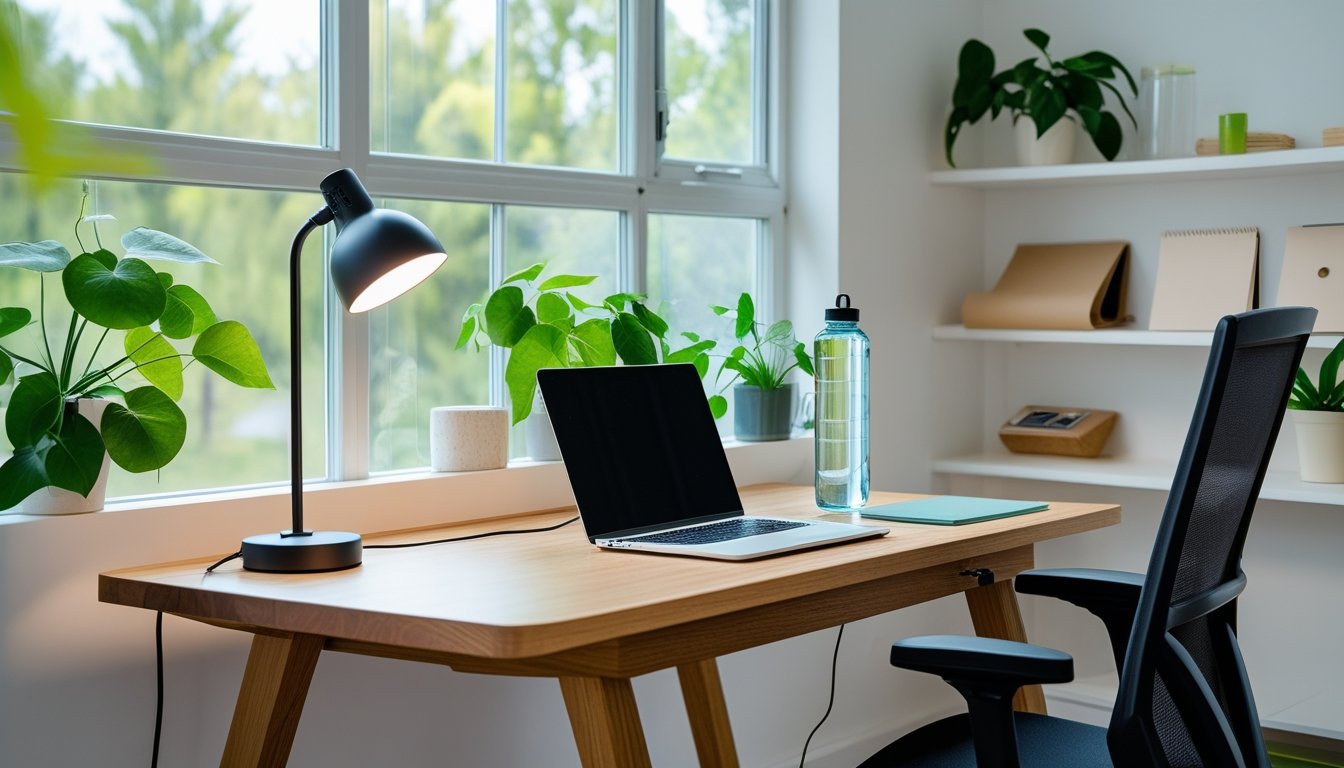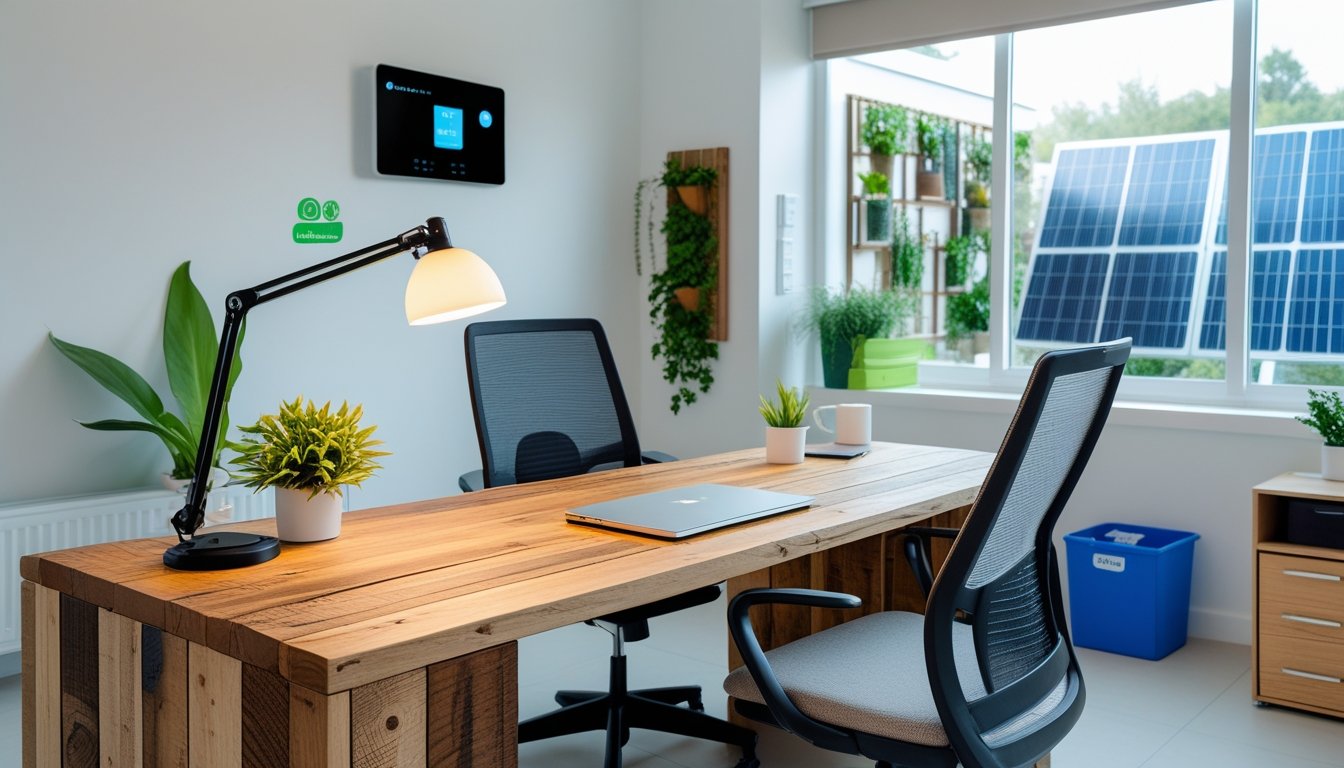Late updated: 03 Aug 2025 10:08
Written by: Eleanor Hartman
Sustainable Home Office Setup for Energy Efficiency: Creating an Eco-Friendly Workspace
Creating a sustainable home office isn't just a modern trend; it's a smart way to make our work environment healthier and more energy-efficient. With more of us working from home, it's crucial to consider how our workspace affects both our energy consumption and overall well-being. By embracing energy efficiency and sustainability, we can lower our energy bills and reduce our carbon footprint all at once.

Imagine starting each workday in a space designed to save both energy and resources. When we choose sustainable furniture, utilise natural light, and invest in energy-efficient technology, we're not only caring for the environment but also creating a more inspiring place to work. It's these thoughtful choices that turn everyday routines into opportunities for positive impact.
In this blog post, we'll explore practical strategies for setting up a sustainable home office that maximises energy efficiency. From opting for smart lighting solutions to selecting eco-friendly office supplies, we aim to provide you with actionable ways to transform your workspace.
Key Takeaways
- Sustainable home office setups save energy and reduce costs.
- Eco-friendly elements enhance work comfort and productivity.
- Practical tips are available to make your office greener.
Core Elements of a Sustainable Home Office Setup

In creating a sustainable home office, we must prioritise energy conservation and efficiency. Key aspects include the strategic use of energy-saving equipment, the effective harnessing of natural light, and exploring renewable energy solutions for long-lasting sustainability.
Optimising Energy Consumption
A key component of a sustainable home office is the optimisation of energy consumption. We can achieve this by incorporating energy-efficient practices that minimise waste. Simple steps, such as turning off electronics when not in use and using smart power strips, can significantly reduce unnecessary energy usage.
Adjusting the thermostat appropriately and sealing windows to maintain desired temperature levels also helps. Monitoring systems that track energy usage can provide valuable insights, enabling us to identify further areas for improvement and ensure our home offices remain efficient.
Selecting Energy-Efficient Equipment
Choosing the right equipment plays a vital role in our sustainable office setup. Energy Star rated equipment, including computers, printers, and other appliances, ensures reduced energy use. These devices are designed to use significantly less power without compromising performance.
Investing in smart devices, like programmable thermostats, can enhance our office's energy efficiency. We must consider the durability and lifespan of our equipment, opting for products that are not only efficient but also built to last, reducing long-term waste and environmental impact.
Utilising Natural Light Effectively
Maximising natural light is a sustainable choice that benefits both our energy bills and workspace ambiance. Proper placement of desks near windows decreases our reliance on artificial lighting during the day. We can enhance this by using light-coloured walls and furnishings to reflect daylight further into the room.
Installing energy-efficient window treatments that minimise heat gain in summer and heat loss in winter is essential. They help maintain comfortable conditions passively. Furthermore, strategically using mirrors can increase natural light's reach, reducing the necessity for additional lighting during working hours.
Integrating Renewable Energy Options
Incorporating renewable energy sources is crucial for a truly sustainable office. Small-scale solar panels, for example, can be installed to harness sunlight and generate electricity for our office needs. This not only reduces our dependence on grid electricity but also cuts down on associated carbon emissions.
Utilising energy storage solutions, such as solar batteries, ensures we have power even during grid outages. Exploring renewable energy plans with providers and integrating eco-friendly solutions underscores our commitment to sustainability while lowering long-term energy costs.
Practical Strategies for Energy-Efficient Home Offices
Creating a sustainable home office requires thoughtful planning and the adoption of energy-efficient practices. We focus on integrating technology like programmable thermostats, minimising energy wastage through reducing phantom loads, and fostering energy-saving behaviours.
Implementing a Programmable Thermostat
A programmable thermostat allows us to control the heating and cooling schedule of our home office efficiently. By setting specific temperatures for different times of day, we can avoid unnecessary heating or cooling. For instance, the thermostat can lower the temperature during working hours when a more moderate climate is acceptable and raise it at times when the office is not in use.
Programmable features enable reductions in energy consumption, which can also lower utility bills. We should look for models that are user-friendly, offering features like smart learning capabilities that adjust based on our habits. This technology not only contributes to energy efficiency, it enhances comfort in our workspace.
Reducing Phantom Loads and Standby Power
Phantom loads, also known as standby power, refer to the electricity consumed by devices that are turned off but still plugged in. Devices like printers, chargers, and even some monitors can draw power when not in use. To tackle this issue, unplugging devices or using power strips with on/off switches can help.
Power strips with built-in surge protectors provide the additional benefit of protecting devices from power surges. We should also consider investing in smart plugs that monitor energy usage and can be controlled remotely, allowing us to cut off power to devices that are not in use. These small changes can contribute significantly to reducing energy wastage.
Enhancing Energy Saving Behaviours
Encouraging energy-saving behaviours is crucial in sustaining a green home office. Simple actions like utilising natural light as much as possible and turning off lights when not needed make a tangible difference. Using task lighting—like LED desk lamps—can also conserve energy.
We must adopt habits like shutting down computers at the end of the day and activating power-saving modes on all electronic devices. These behaviours, combined with using energy-efficient equipment, can lead to noticeable reductions in energy consumption. Equipping ourselves with information about energy-efficient practices empowers us to make conscious choices that benefit both our budget and the environment.
Frequently Asked Questions

In our journey towards creating sustainable home offices, energy efficiency plays a crucial role. By optimising lighting, selecting efficient appliances, and incorporating smart devices, we can significantly reduce energy consumption.
What are the best practices for reducing energy consumption in a home office?
Reducing energy consumption starts with choosing energy-efficient appliances and equipment. Use LED lighting instead of traditional bulbs. Invest in power strips with automatic shutdown features. Regularly turn off devices when they are not in use. Implementing a schedule for heating and cooling systems can significantly cut down on energy use.
How can I optimise natural lighting in my workspace to minimise electric lighting use?
Position your desk near windows to maximise daylight use. Utilise sheer curtains to soften harsh sunlight without blocking it. Paint walls with light, reflective colours to enhance natural brightness. Rearrange furniture to avoid obstructing light paths, ensuring the room receives ample illumination throughout the day.
What are the most energy-efficient appliances for a home office?
Investing in ENERGY STAR-rated equipment is vital for energy efficiency. Modern computers and monitors that consume less electricity are excellent choices. Consider multifunctional devices like a printer-scanner combo to save both energy and space. Laptops generally consume less power than desktops, making them preferable for a sustainable setup.
How does insulation contribute to energy efficiency in a home office?
Proper insulation maintains temperature by reducing heat exchange between outside and inside environments. Well-insulated walls, ceilings, and floors lessen the need for excessive heating or cooling. Sealing gaps around windows and doors prevents drafts, ensuring the workspace remains comfortable with lower energy use.
Can you recommend any smart home devices that help in monitoring and reducing energy usage?
Smart thermostats monitor and adjust heating and cooling based on room occupancy. Energy meters provide real-time feedback on usage, allowing us to identify and rectify wasteful practices. Smart plugs can automate devices, shutting them down when not needed, which helps prevent unnecessary energy draw.
What role do renewable energy sources play in creating a sustainable home office environment?
Incorporating renewable energy, like solar panels, can significantly offset energy demands. Using renewable resources reduces reliance on traditional power grids, thus decreasing our carbon footprint. By investing in renewable technologies, we can create a more sustainable and self-sufficient workspace.